Case reports are the first line of evidence in documenting clinical phenomena in the peer-reviewed literature. from How to write a case report for publication
 Case reports, also known as case studies, are published articles which focus narrowly on some medical event as it actually happened. Recall from the introduction to evidence-based medicine that evidence-based practice includes the practitioner’s expertise in addition to clinical evidence and patient preferences. Expertise takes time to develop, and no provider can ever have experience in all areas. One practical solution to this dilemma is publishing close examinations of a medical situation, be it a patient, procedure, or course of treatment. Such tightly-focused reports bridge the gap between the highly controlled world of research and the more dynamic realm of clinical practice, in essence permitting individual expertise to be widely shared.
Case reports, also known as case studies, are published articles which focus narrowly on some medical event as it actually happened. Recall from the introduction to evidence-based medicine that evidence-based practice includes the practitioner’s expertise in addition to clinical evidence and patient preferences. Expertise takes time to develop, and no provider can ever have experience in all areas. One practical solution to this dilemma is publishing close examinations of a medical situation, be it a patient, procedure, or course of treatment. Such tightly-focused reports bridge the gap between the highly controlled world of research and the more dynamic realm of clinical practice, in essence permitting individual expertise to be widely shared.
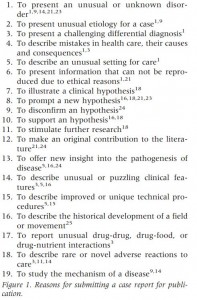 There are 3 different sorts of case studies: 1) case examples of typical or atypical patients; 2) case studies of typical or atypical interventions/outcomes; 3) case studies of a complex problem. Generally, patient case studies begin with a concise statement of the pathology/medical/clinical area of the case, then provide a key significance statement, followed by a brief overview of the patients being presented. The body is made up of the case example itself with analysis relevant to the purpose of the article (see 1-3 above). Case reports finish with a Discussion section that explicitly connects the lesson of the case to patient care and perhaps suggestions for research.
There are 3 different sorts of case studies: 1) case examples of typical or atypical patients; 2) case studies of typical or atypical interventions/outcomes; 3) case studies of a complex problem. Generally, patient case studies begin with a concise statement of the pathology/medical/clinical area of the case, then provide a key significance statement, followed by a brief overview of the patients being presented. The body is made up of the case example itself with analysis relevant to the purpose of the article (see 1-3 above). Case reports finish with a Discussion section that explicitly connects the lesson of the case to patient care and perhaps suggestions for research.
Case studies also come in 2 flavors: plain vanilla case reporting for which the Discussion section is the main site of analysis, and a more exotic version that includes a literature review in addition to a Conclusion. We’ll start with the simpler version as it is more likely to be the first kind you’ll need to write. Then we’ll tackle case reports that incorporate lit reviews.
 Simple Case Reports
Simple Case Reports
Case reports are organized in three sections, typically using the functional subheadings: Introduction, Case, and Discussion. When reporting more than one case, then each gets its own subheading, e.g. “Case#1, Case#2”, etc.
Writing Case Report Introductions
As with all Introductions, the reader needs to know the topic area of the case and the motivation for publication. Because the purpose of a case study is educational, you can assume the reader intends to better understand some aspect of patient care. Hence, “motivation” is identified by clarifying what makes the case a learning opportunity.
There are 3 (or 4) Steps to an effective Introduction.
- State the medical condition or situation.
- Demonstrate that the case is related to medical condition or situation.
- Provide a very brief synopsis of case: make the problem in (2) clearly related and include a brief outcome statement.
- State the significance of this case for readers or within the literature (optional).
Example || http://www.ncbi.nlm.nih.gov/pubmed/20609853
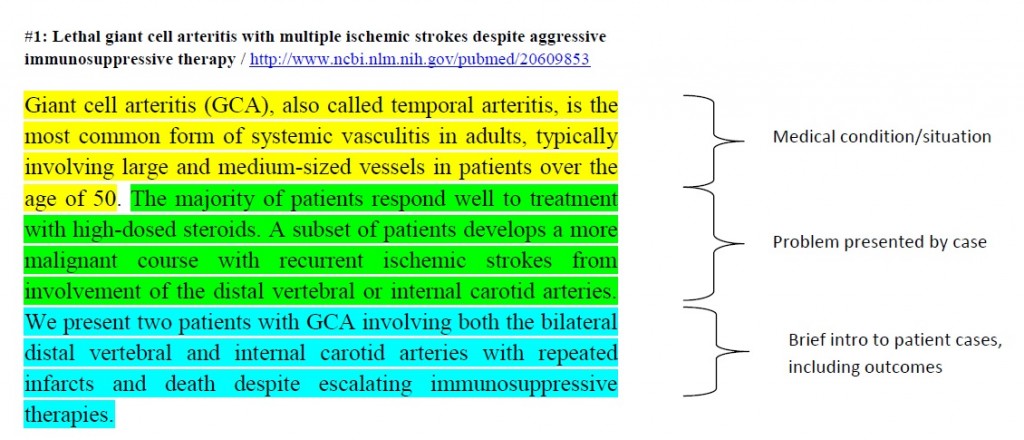
Analysis: In this example, the writer simply immediately identifies the medical condition, explains the normal course of action, and spells out the problem this case addresses. The final sentence introduces the patient case itself.
Example || http://www.ncbi.nlm.nih.gov/pubmed/20661069
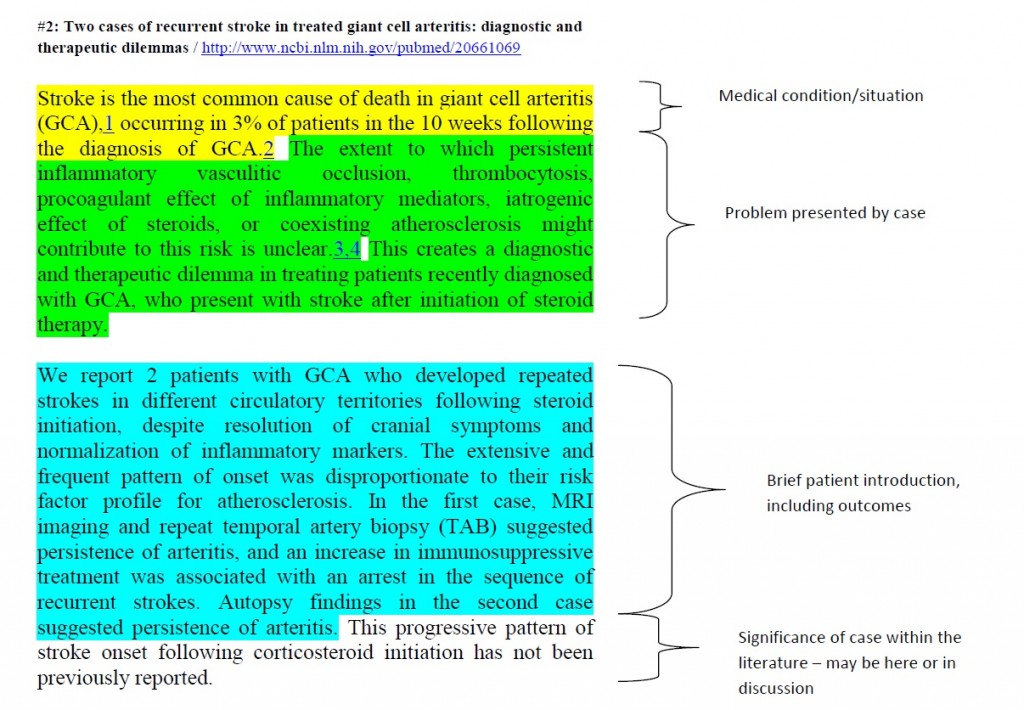
Analysis: This Introduction is a bit longer, but the overall pattern is similar. The medical situation is immediately identified in the first sentence, and then the writer explains the medical complexities driving the case. The second paragraph introduces the patient cases themselves, including the outcomes of treatment. The final sentence declares the significance of this case in the published literature.
Example || http://www.ncbi.nlm.nih.gov/pubmed/15211163
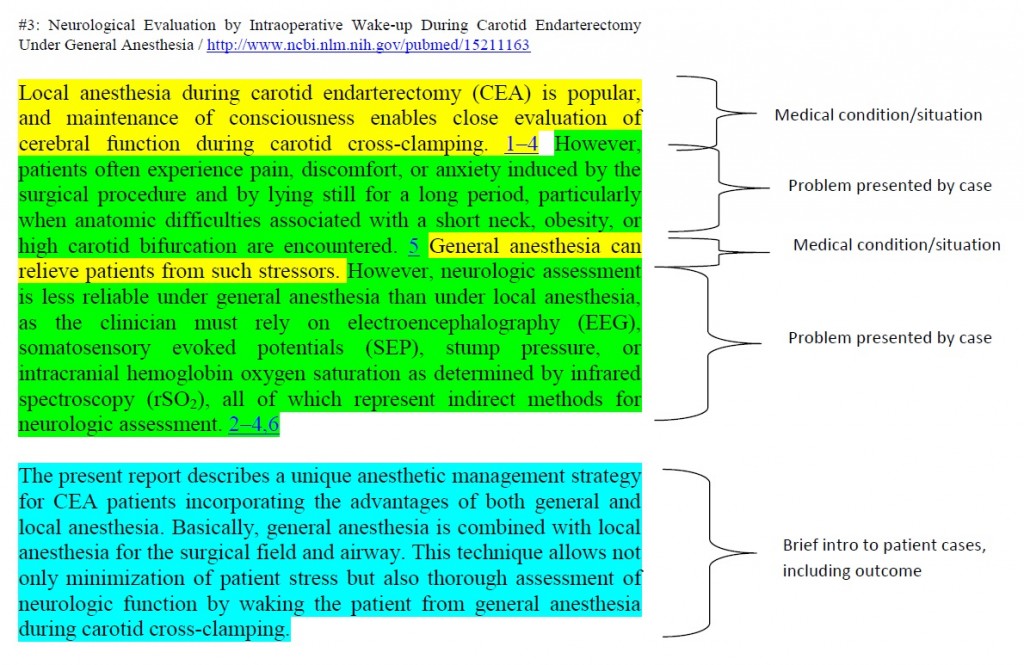
Analysis: This case reports on a variation of a standard procedure. Hence, the first sentences both identify the normal procedural options as well as the problems associated with them. The second paragraph provides the brief, outcome-oriented patient histories. Note the “case” here is a close focus on the intervention itself.
Writing the Case
Most case reports are pedagogical — the reader is intended to learn something new about care of a particular type of patient. To achieve this end, the body of the case report is simply the history of the case itself, from initial presentation to atypical responses/treatments determining outcome/s. Presentation follows the clinical process. The case presentation may be quite brief or longer depending on the case itself. This is the “evidence” portion of the paper so no interpretation or speculation is included.
Example || http://www.ncbi.nlm.nih.gov/pubmed/21549607
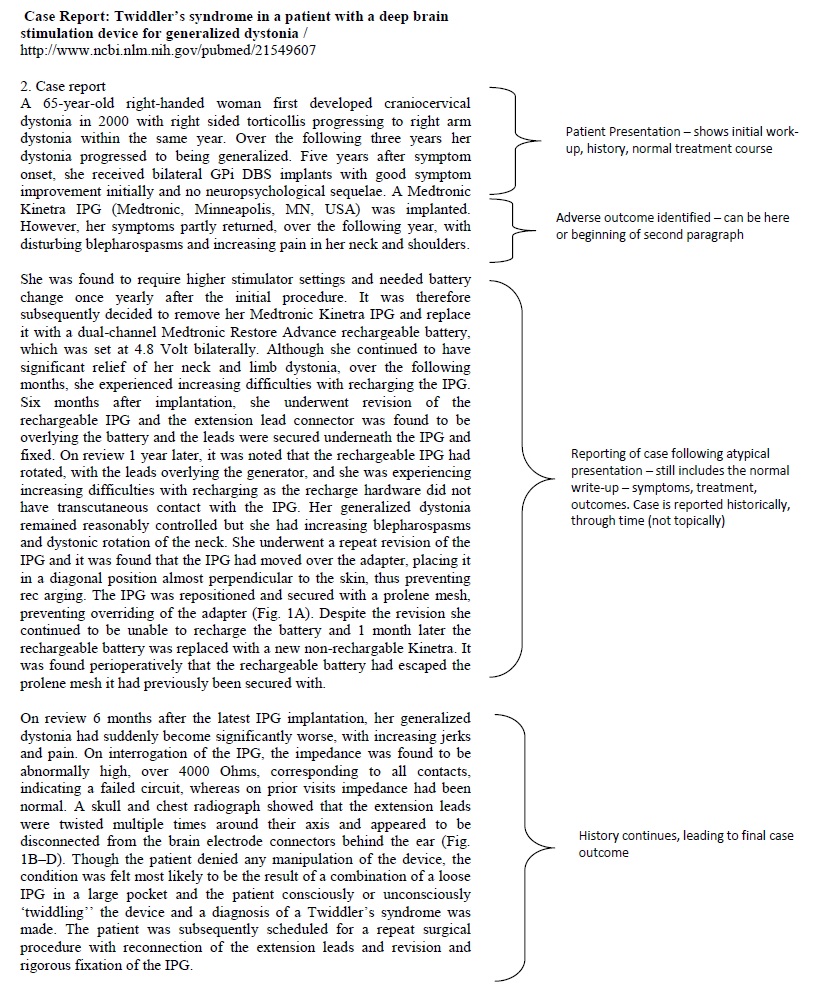
Analysis: The most salient aspects of the patient’s history are reported, following the format of patient histories: relevant demographic information, diagnosis, treatment, and outcome. Note this is a synopsis, not a detailed account. The writer then identifies the atypicality of the case, provides history of this event, and the final outcome.
Writing Tip: The case is presented historically, not topically, just as it would occur in the medical record. No interpretation or analysis is included in the case history. Hence, the body of a case study is analogous to the middle sections of a research report: Methods and Results.
Example || http://www.ncbi.nlm.nih.gov/pubmed/20661069
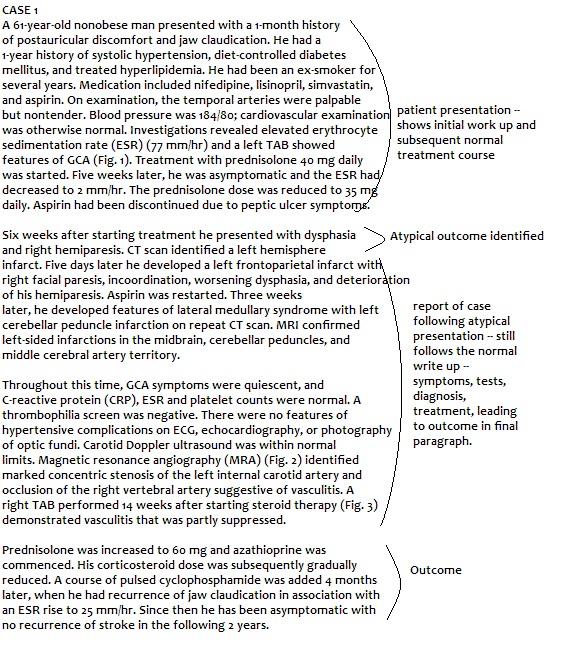
Analysis: As in the previous example, the patient case is presented chronologically, emphasizing only the most salient aspects of the case as related to the purpose of the case study.
Writing the Discussion
The Discussion section of a case study can be quite lengthy, and is somewhat similar to that of a research report in that the writer wishes to situate the current case against what is known from the published literature and make suggestions for how these cases may lead to changes in clinical decision-making and/or for future research. There is little “relational dialogue”, though — the writer is not trying to make field-wide claims comparing one case to another. Instead, the writer is carefully pointing out what in the literature can explain a case outcome and what cannot — from there, the writer is free to speculate (again, carefully! we’re still talking about science here) on what the case vis-a-vis the literature suggests for practice and research. The content of the Discussion tends to be organized along some facet of the clinical process — symptoms, treatment, etc — whatever it is that made the case noteworthy enough for publication.
In terms of organization, Discussions begin with a brief restatement of the medical event that makes the case noteworthy, reminding the reader of the main focus of the publication. The body of the Discussion is where the writer presents the analysis of salient features. Discussions end with suggestions for how the information can be used in practice or research, and may also include a statement of overall significance.
Each body paragraph addresses a single issue with the pertinent literature and analysis. An outline would look something like this:
- Noteworthy Point 1
- associated literature
- speculations
- recommendations (clinical practice, research)
- Noteworthy Point 2
-
- associated literature
- speculations
- recommendations (clinical practice, research)
-
- Noteworthy Point 3
-
- associated literature
- speculations
- recommendations (clinical practice, research)
-
- repeat as necessary
Example ||
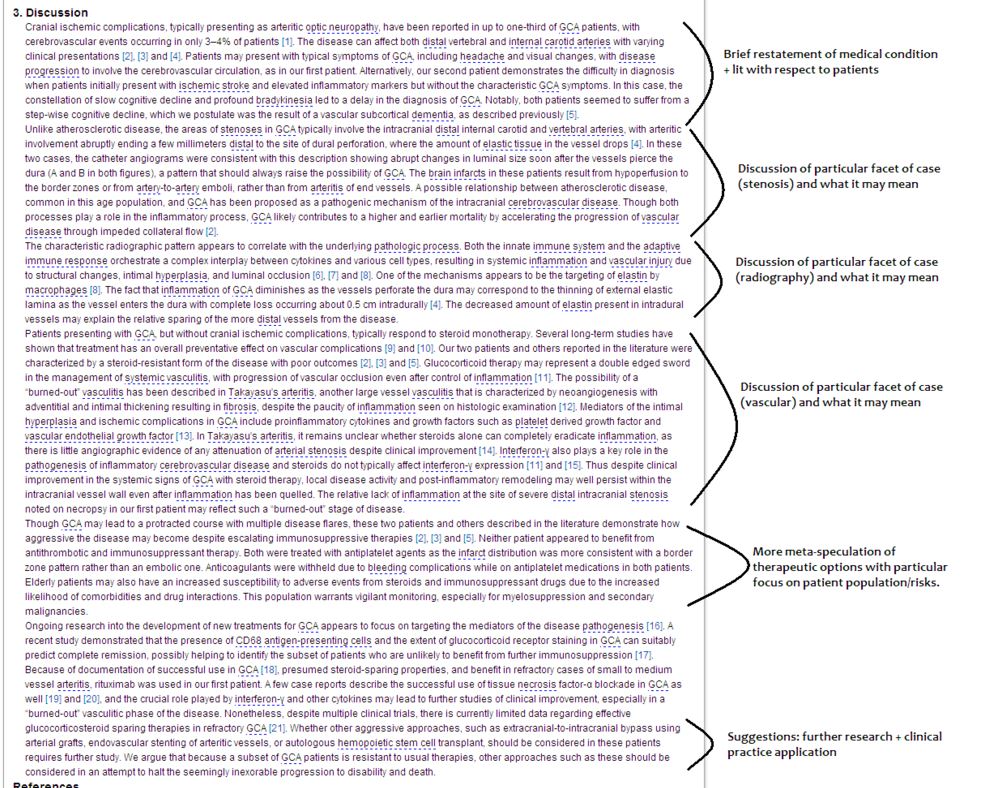
Analysis: The writer begins by restating the medical situation, and proceeds to discuss the case in a carefully controlled manner: each paragraph takes on a single facet of the case and speculates on its role, using the literature as support. The Discussion ends with suggestions for research based on the outcomes of the case, and also includes a firmly worded argument regarding patient care.
 Complex Case Reports: Adding a literature review
Complex Case Reports: Adding a literature review
Case Report + Reviews are a hybrid genre that can be considered a case report on steroids or a review paper with real-world (clinical) exemplification. Overall, these papers are treated first as case studies and secondly as reviews. The format reflects the dual character with a combination of functional and topical headings, though not all reviews will feature topical subheadings. The order of events is Introduction, Case, Review, Conclusion.
Writing the Case+Review Introduction
The introduction must accomplish the normal tasks of introducing the clinical situation, as in simple case reports, and also the task of framing the case into the larger literature, as happens in a review.
Since both start with some mention of the topic, the opening sentences are quite similar to either case reports or reviews. After, a more in-depth presentation of the condition follows, as in a review, leading to a “motivation” (gap) type statement that narrows to the topic to the clinical focus of the paper. The introduction ends there, and the next section begins the case presentation, proceeds to a case-focused review of the literature, then ends with a Discussion.
5 Steps to the Case Report + Review Introduction
- State medical condition or situation and provide extended definition. State significance of this condition/situation in practical, clinical, or research terms.
- Provide brief Lit Review that focuses on motivation for case report and review.
- Identify the problem the case presents vis-à-vis the medical condition or situation.
- Provide brief patient introduction: make the problem in (2) clearly related and include a brief outcome.
- Establish significance of this case. Provide a brief preview or focus statement of the body sections.
Note: there is a lot of variation in order of the above steps!
Example || http://www.ncbi.nlm.nih.gov/pmc/articles/PMC2851695
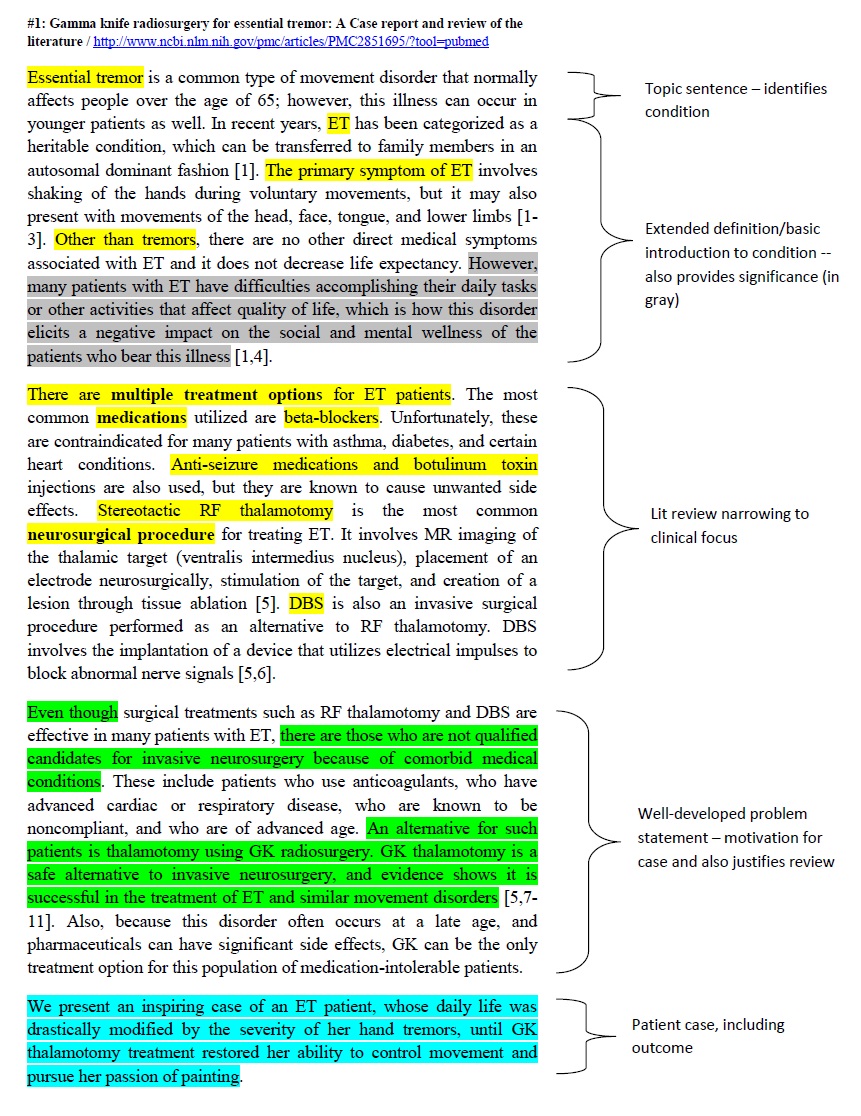
Analysis: Note that the title of the article specifies both a case report and a lit review are included. Explicitly naming publication genres in the title is the norm when an article is anything other than a classic IMRD research report. Titles are the first communication gesture, and accurately signaling content is both courteous and clever. In the first paragraph, the writer immediately identifies the medical condition which is the focus of the case. Because treatment of the condition is multi-factorial, the writer includes a longer introduction. In addition, motivation for said lit review needs to be provided, and that is motivated through the conflict introduced by the case: the need for a non-invasive surgical alternative to treat non-qualifying patients.
Example || http://www.ncbi.nlm.nih.gov/pubmed/20935328
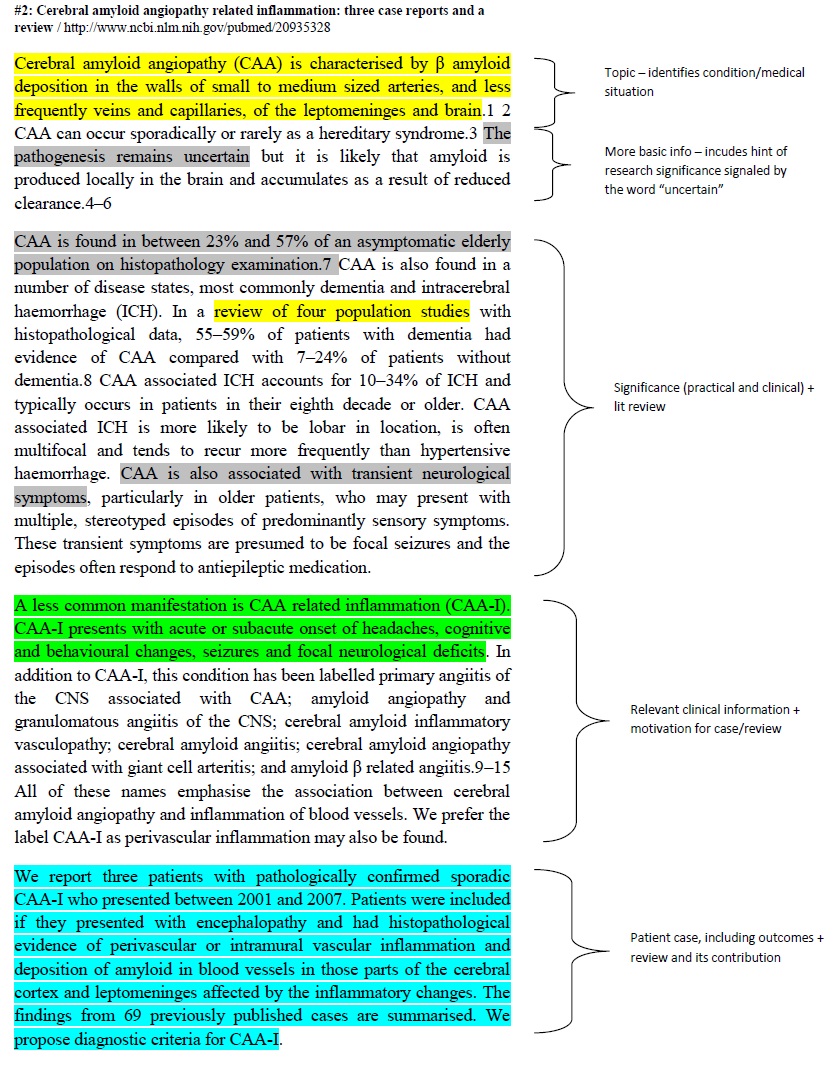
Analysis: Introductions to case reports + reviews are longer and more complex. Both the Case and Review require motivation. This introduction exemplifies this well. The complicated nature of the medical condition is discussed first, with subsequent paragraphs taking up reasons for why this condition merits exploration through both the literature and case histories.
Writing the Review
Case reports+Reviews are more complicated because the middle section contains both the case report and the review section. Cases are written just as they are for a regular case report.
The distinguishing feature is the review. The review is highly focused on the topic of the case, but may not reference the case itself. Shorter reviews may not have subheadings; longer or more topically complex reviews do use subheadings. The first paragraph of the review may use an overview sentence signaling the topic subheadings. (As in any review, if subheadings are used, an overview sentence is much appreciated.)
Example || http://www.ncbi.nlm.nih.gov/pmc/articles/PMC2851695 (case followed by review section)
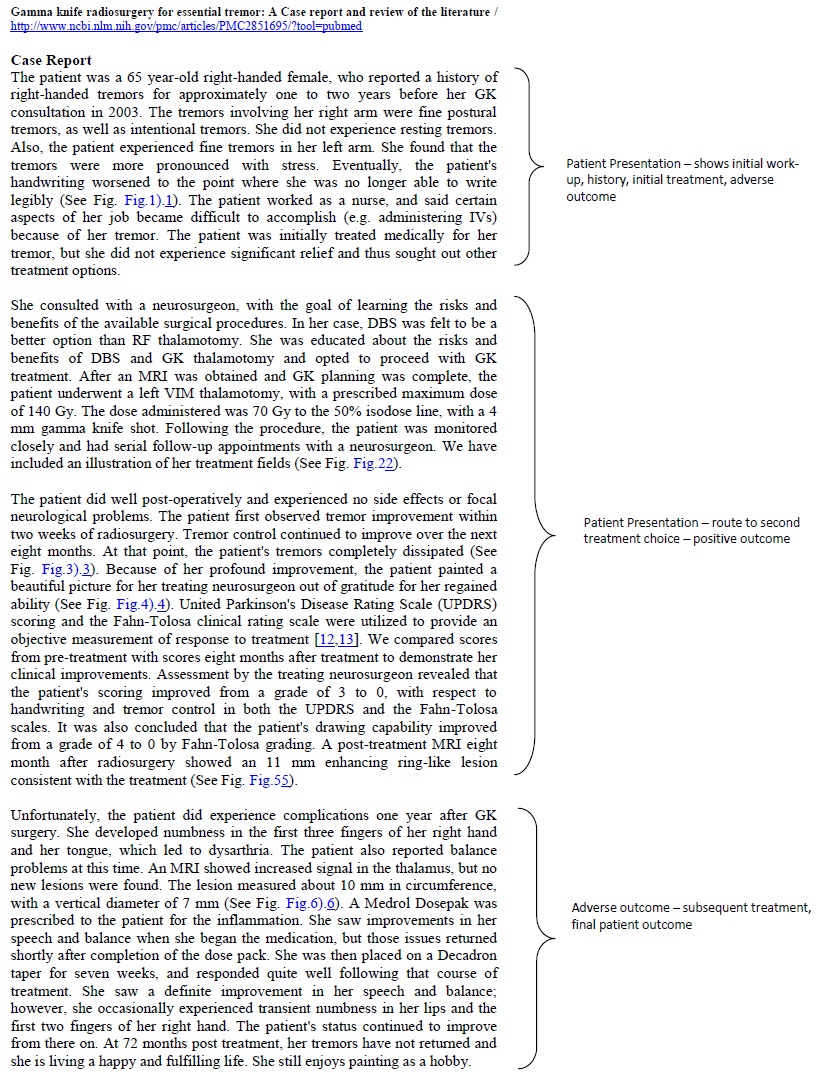
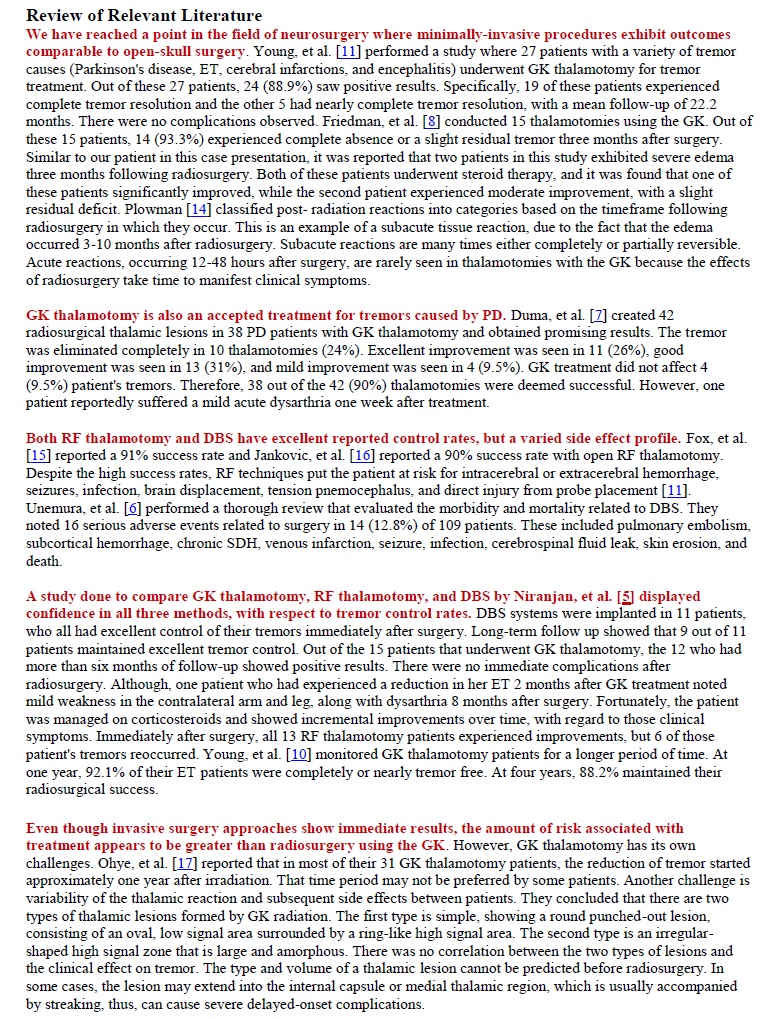
Analysis: Specifically, note the sentences in deep red. Each is a classic topic sentence, of the same sort you may remember from 8th grade English! Topic sentences are a much under-valued commodity in science prose. This is complicated stuff for both the reader and the writer. Readers need and deeply appreciate the explicit signal embedded in a topic sentence. Writers benefit from having that key idea gazing at them, encouraging cohesion and coherence in each paragraph.
Example || http://www.ncbi.nlm.nih.gov/pubmed/20935328 (Note: review paragraphs are excerpts)
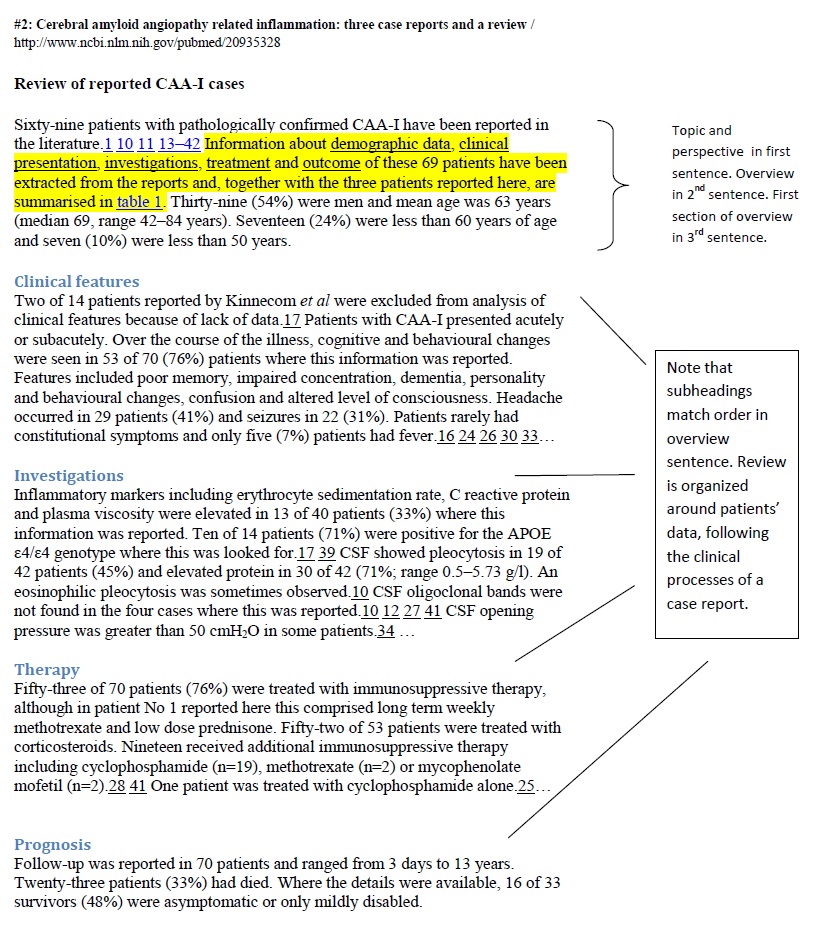
Analysis: This writer chose to use subheadings to organize the review, as is done in review articles. Subheadings signal content and each section is restrained to only that material. An overview statement is provided in the first paragraph, designating both the perspective driving the review (only cases of pathologically confirmed CAA-I) and the road map detailing the upcoming content.
Writing the Conclusion of a Case + Review
The Case report + Review has a brief concluding section: the majority of the information has already taken place — what is needed is a synthesis statement of the case, a synthesis statement of the review, and a recommendation for what should happen with this information. Optionally, authors may also include a final thought of their own regarding the case. This small bit of personalization is permitted in case studies, and rarely found in other medical literature, reflecting the human-centered subject of the writing.
Example || http://www.ncbi.nlm.nih.gov/pmc/articles/PMC2851695
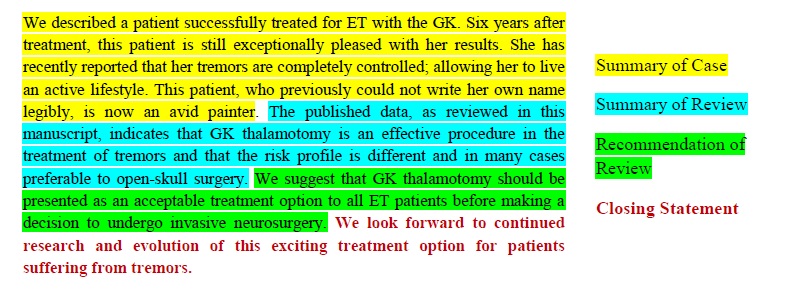
Action Plan and Outline
Case reports are close examinations of an interesting patient case, intervention, or medical situation. Before writing one, you’ll need an experience to report on! Further, the information needed to report the case must be complete, which means the case notes, history, data points, etc. must all be accurate, accessible, and complete.
Before you write
- A completed case experience with good notes
- A completed annotated bibliography, especially for the discussion section. This is usually the part of the process that takes the longest to complete. Allow 2-3 weeks for this research.
Schedule
This schedule assumes the case is already finished or is complete enough to write about with a clear beginning, middle, and end.
Week 1 — Draft Introduction — if lit review is included, outline the literature review
Week 2 — Draft the Body of the case — if included, draft brief literature review, then the body of the case
Week 3 — Draft the Discussion